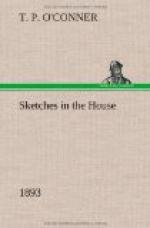[Sidenote: The new Ministry.]
One after another, the new Ministers followed—their receptions varying with their popularity—and at last they were all seated on the Treasury Bench. In their looks there was ample indication of the intellectual supremacy which had raised them to that exalted position. Mr. Gladstone had Sir William Harcourt—his Chancellor of the Exchequer—on his right, and on his left sat Mr. John Morley, with his thin face and smile, half ascetic, half kindly. Then came the newest man of the Government, that fortunate youth to whom power and recognition have come, not in withered or soured old age, but in the full prime of his manhood. Mr. Asquith takes his seat next Mr. Morley; and it is, perhaps, the close proximity which suggests the strong physical likeness between the two. Both are clean shaven; both have the long narrow profile that is called hatchet-faced; in both there is the compression of lips that reveals depths of strength and tenacity; both have the slightly ascetic air of the philosopher turned politician; both look singularly young, not only for their years, but for the dazzling eminence of their positions.
[Sidenote: Other groups.]
Meantime, there are other groups in the House that are gradually forming, and that have since played a momentous part in this great Session. Mr. Labouchere sits in his old place below the gangway—a seat which has become his almost by right of usage, but which he has to secure still every day, by that regular attendance at prayers which is so sweet to a devout soul. Next him sits Mr. Philipps—one of the younger generation of Radicals; and then comes Sir Charles Dilke—very carefully dressed, looking wonderfully well—rosy-cheeked, and altogether a younger-looking and gayer-spirited man than the haggard and pale figure which used to sit on the Treasury Bench in the days of his glory. John Burns is up among the Irish and the Tories, in visible opposition to all Governments. There is something breezy about John Burns that does one good to look at. He wears a short coat—generally of a thick blue material, that always brings to one’s mental eye the flowing sea and the mounting wave.




